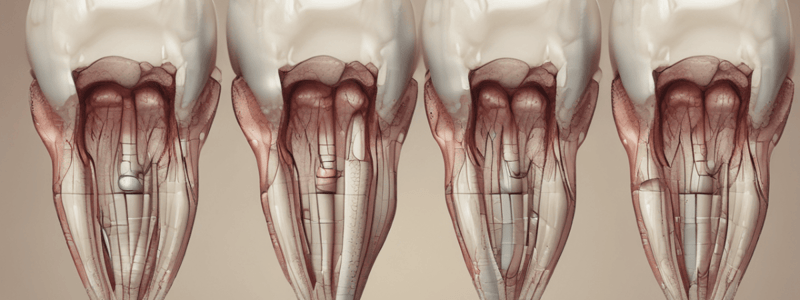Podcast
Questions and Answers
What is the term for the congenital absence of tooth germ of the entire dentition?
What is the term for the congenital absence of tooth germ of the entire dentition?
- Microdontia
- Anodontia (correct)
- Oligodontia
- Macrodontia
What is the result of hyperactivity of the dental lamina?
What is the result of hyperactivity of the dental lamina?
- Oligodontia
- Anodontia
- Supernumerary teeth (correct)
- Microdontia
What is the term for an abnormally larger tooth?
What is the term for an abnormally larger tooth?
- Fusion
- Macrodontia (correct)
- Microdontia
- Gemination
What is the result of abnormal proliferation of inner enamel epithelium into the stellate reticulum?
What is the result of abnormal proliferation of inner enamel epithelium into the stellate reticulum?
What occurs during the cap stage of tooth development?
What occurs during the cap stage of tooth development?
What is the term for the abnormal invagination of the enamel organ into the dental papilla?
What is the term for the abnormal invagination of the enamel organ into the dental papilla?
What is the antibiotic responsible for discoloration of enamel and dentin during tooth development?
What is the antibiotic responsible for discoloration of enamel and dentin during tooth development?
What is the stage of tooth development where enamel organs of both dentitions are formed?
What is the stage of tooth development where enamel organs of both dentitions are formed?
Which of the following teeth are most commonly found missing?
Which of the following teeth are most commonly found missing?
What is the name of the condition where a tooth is absent?
What is the name of the condition where a tooth is absent?
What is the term for the union of adjacent tooth germs?
What is the term for the union of adjacent tooth germs?
What is the consequence of occlusal wear or fracture of Dens Evaginatus?
What is the consequence of occlusal wear or fracture of Dens Evaginatus?
What is the result of abnormal proliferation of the tooth germ at the bud stage?
What is the result of abnormal proliferation of the tooth germ at the bud stage?
What is the most common type of supernumerary tooth?
What is the most common type of supernumerary tooth?
What is the result of aberration in tooth initiation?
What is the result of aberration in tooth initiation?
What is the stage of tooth development where tooth shape and size are determined?
What is the stage of tooth development where tooth shape and size are determined?
What is the term for extra teeth that form due to abnormal initiation?
What is the term for extra teeth that form due to abnormal initiation?
What is the process by which the enamel organ formed due to initiation gives the crown of the tooth its final size and shape?
What is the process by which the enamel organ formed due to initiation gives the crown of the tooth its final size and shape?
How many stages are involved in the development of a tooth?
How many stages are involved in the development of a tooth?
What is the result of disturbance in proliferation during tooth development?
What is the result of disturbance in proliferation during tooth development?
What is the process by which cells prepare themselves to carry out their function during tooth development?
What is the process by which cells prepare themselves to carry out their function during tooth development?
What is the result of vitamin A deficiency on tooth development?
What is the result of vitamin A deficiency on tooth development?
What is the type of dentin formed by odontoblasts that fail to differentiate properly due to vitamin A deficiency?
What is the type of dentin formed by odontoblasts that fail to differentiate properly due to vitamin A deficiency?
What is the process by which inner enamel epithelial cells differentiate into ameloblasts?
What is the process by which inner enamel epithelial cells differentiate into ameloblasts?
Flashcards are hidden until you start studying
Study Notes
Development of a Tooth
- The development of a tooth can be studied under five histophysiological stages: initiation, proliferation, histodifferentiation, morphodifferentiation, and apposition.
- Initiation of tooth development depends on epithelial-ectomesenchymal interaction, and lack of initiation results in anodontia (congenital absence of tooth germ).
Abnormalities in Tooth Development
- Anodontia: congenital absence of tooth germ of the entire dentition, commonly affecting upper lateral incisors, third molars, and lower second premolars.
- Oligodontia: absence of single or multiple tooth germs.
- Supernumerary teeth: teeth present in addition to the normal number, resulting from hyperactivity of the dental lamina, commonly seen as mesiodens (between two upper central incisors) and paramolars (by the side of the molars).
- Macrodontia: abnormally larger tooth, and Microdontia: abnormally smaller tooth, resulting from abnormal proliferation of the tooth germ at the bud stage.
- Gemination: division of tooth germ, and Fusion: union of adjacent tooth germs, occurring during the cap stage of tooth development.
- Dens Invaginatus: abnormal invagination of the enamel organ into the dental papilla, causing an appearance of tooth within a tooth.
- Dens Evaginatus: cusp-like elevation seen on the occlusal surface of premolars or molars, resulting from abnormal proliferation of inner enamel epithelium into the stellate reticulum.
Tetracycline Staining
- Tetracycline staining: discoloration of enamel and dentin due to ingestion of the antibiotic during mineralization, resulting in tooth discoloration.
Histodifferentiation
- Histodifferentiation: process where cells undergo structural and biochemical changes to carry out their function, seen in the bell stage.
- Inner enamel epithelium influences adjacent cells of the dental papilla to differentiate into odontoblasts, forming the dentin matrix.
- Ameloblasts form the enamel matrix through reciprocal induction.
Studying That Suits You
Use AI to generate personalized quizzes and flashcards to suit your learning preferences.




